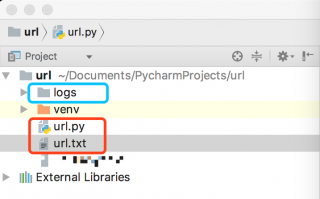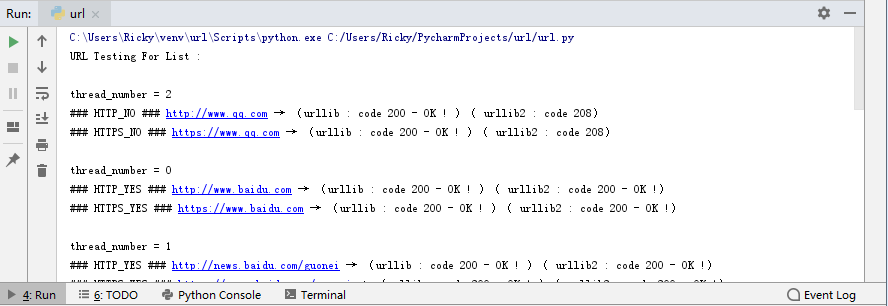本篇文章是《用不到 200 行的 Python 代码编写一个批量检测 URL 是否可以访问的脚本》的扩展,本篇文章最重要的部分是增加了多线程操作,大大节约了检测 URL 所需要的时间;以及对日志的写入进行了优化。在阅读本篇文章前请先阅读上一篇文章,很多东西将不再赘述。
本篇文章描述的脚本依旧会对每个 URL 检测四次,其中 http 检测两次,https 检测两次(为什么是四次?详情请见上一篇文章)。
首先是包的导入和浏览器所使用的 User-Agent 的定义:
# coding=utf-8
import httplib, urllib, urllib2, ssl, time, os, threading
HEADERS = {'User-Agent':'Mozilla/5.0 (Windows NT 6.1; Win64; x64) AppleWebKit/537.36 (KHTML, like Gecko) Chrome/65.0.3298.4 Safari/537.36'}
因为这个版本增加了多线程,所以多引入了一个名为 threading 的包。
紧接着是 show_status_urllib(url) 和 show_status_urllib2(url) 两个检测方法,这里面捕获了大量的异常;以及一个用于处理所返回的网页状态码的函数 return_code(function_name, response) :
def show_status_urllib(url):
function_name = 'urllib'
try:
response = urllib.urlopen(url)
except IOError, e:
return False, function_name + ' : IOError - ' + e.message
except ssl.CertificateError, e:
return False, function_name + ' : CertificateError - ' + e.message
except httplib.BadStatusLine, e:
return False, function_name + ' : httplib.BadStatisLine - ' + e.message
else:
return return_code(function_name, response)
def show_status_urllib2(url):
function_name = 'urllib2'
try:
# request = urllib2.Request(url)
request = urllib2.Request(url, '', HEADERS)
response = urllib2.urlopen(request)
except urllib2.HTTPError, e:
return False, function_name + ' : HTTPError code ' + str(e.code)
except urllib2.URLError, e:
return False, function_name + ' : URLError - ' + str(e.reason)
except IOError, e:
return False, function_name + ' : IOError - ' + e.message
except ssl.CertificateError, e:
return False, function_name + ' : CertificateError - ' + e.message
except httplib.BadStatusLine, e:
return False, function_name + ' : httplib.BadStatisLine - ' + e.message
else:
return return_code(function_name, response)
def return_code(function_name, response):
code = response.getcode()
if code == 404:
return False, function_name + ' : code 404 - Page Not Found !'
elif code == 403:
return False, function_name + ' : code 403 - Forbidden !'
elif code == 200:
return True, function_name + ' : code 200 - OK !'
else:
return False, function_name + ' : code ' + str(code)
这三个方法与之前脚本里的基本一致。
接下来是一个用于格式化日志的函数,以及一个对 URL 进行四次检测的函数:
def return_log(protocol, is_true, url, urllib_log, urllib2_log):
if is_true:
return '### ' + protocol + '_YES ### ' + url + ' → (' + urllib_log + ' )( ' + urllib2_log + ')'
else:
return '### ' + protocol + '_NO ### ' + url + ' → (' + urllib_log + ' )( ' + urllib2_log + ')'
def request_url(url):
url = url.strip().replace(" ", "").replace("\n", "").replace("\r\n", "")
http_url = 'http://' + url
is_http_urllib_true, http_urllib_log = show_status_urllib(http_url)
is_http_urllib2_true, http_urllib2_log = show_status_urllib2(http_url)
https_url = 'https://' + url
is_https_urllib_true, https_urllib_log = show_status_urllib(https_url)
is_https_urllib2_true, https_urllib2_log = show_status_urllib2(https_url)
return return_log('HTTP', is_http_urllib_true and is_http_urllib2_true, http_url, http_urllib_log, http_urllib2_log)\
+ '\n' + return_log('HTTPS', is_https_urllib_true and is_https_urllib2_true, https_url, https_urllib_log, https_urllib2_log)
从这里开始接下来的部分发生了比较大的变化。
接下来是一个对日志进行分类并将日志保存到文本文件的函数:
LOG_FILE = 0
LOG_HTTP_NO_AND_HTTPS_NO_FILE = 1
LOG_HTTP_NO_BUT_HTTPS_YES_FILE = 2
LOG_HTTP_YES_BUT_HTTPS_NO_FILE = 3
def save_log(log_of_list, line):
line += '\n'
log_of_list[LOG_FILE].write(line)
if '### HTTP_NO ###' in line:
if '### HTTPS_NO ###' in line:
log_of_list[LOG_HTTP_NO_AND_HTTPS_NO_FILE].write(line)
elif '### HTTPS_YES ###' in line:
log_of_list[LOG_HTTP_NO_BUT_HTTPS_YES_FILE].write(line)
elif '### HTTP_YES ###' in line and '### HTTPS_NO ###' in line:
log_of_list[LOG_HTTP_YES_BUT_HTTPS_NO_FILE].write(line)
log_of_list 是一个列表,里面存放了四个打开的 log 文件,这四个 log 文件会在 main() 主函数里自动创建,存放路径是在 logs/ 文件夹下(相对路径),具体如下图所示:


在上一篇文章中没有详细地说明这四个 log 文件具体是存放什么的,但我相信您从代码和文件名里应该能猜出来,这里做个简单地说明:
- log-XXX.txt :存放所有检测结果;
- log-XXX-http-no-and-https-no.txt :存放 http 和 https 均无法访问的检测结果;
- log-XXX-http-no-but-https-yes.txt :存放 https 可以访问但 http 无法访问的检测结果;
- log-XXX-http-yes-but-https-no.txt :存放 http 可以访问但 https 无法访问的检测结果;
- XXX 为日期,精确到秒。
接下来是在每个进程里执行的函数 use_thread(thread_total_number, thread_number, url_of_list, log_of_list) :
def use_thread(thread_total_number, thread_number, url_of_list, log_of_list):
i = -1
for url in url_of_list:
i += 1
if i % thread_total_number == thread_number:
line = request_url(url)
save_log(log_of_list, line)
print 'thread_number = ' + str(thread_number) + '\n' + line + '\n' # 查看当前是哪个进程在运行
# print 'thread_number EXIT = ' + str(thread_number) + '\n' # 查看当前是哪个进程已经运行结束
和启动进程的函数 open_thread(thread_total_number, url_of_list, log_of_list) :
def open_thread(thread_total_number, url_of_list, log_of_list):
threads_for_list = []
for thread_number in range(thread_total_number):
thread = threading.Thread(target=use_thread, args=(thread_total_number, thread_number, url_of_list, log_of_list))
thread.start()
threads_for_list.append(thread)
# 等待所有进程全部退出
for t in threads_for_list:
t.join()
最后是主函数,主函数这里也提供了两种检测方法:一种是通过列表来读取出需要检测的 URL ,另一种是通过文本文件( url.txt )来读取出需要检测的 URL :
def main():
if not os.path.exists('logs'):
os.mkdir('logs')
now_time = time.strftime('%Y-%m-%d-%H-%M-%S', time.localtime(time.time()))
log_of_list = [None, None, None, None]
log_of_list[LOG_FILE] = open('logs/log-' + now_time + '.txt', 'a')
log_of_list[LOG_HTTP_NO_AND_HTTPS_NO_FILE] = open('logs/log-' + now_time + '-http-no-and-https-no.txt', 'a')
log_of_list[LOG_HTTP_NO_BUT_HTTPS_YES_FILE] = open('logs/log-' + now_time + '-http-no-but-https-yes.txt', 'a')
log_of_list[LOG_HTTP_YES_BUT_HTTPS_NO_FILE] = open('logs/log-' + now_time + '-http-yes-but-https-no.txt', 'a')
# 1、检测 list 里的链接
print 'URL Testing For List :\n'
url_of_list = ['www.baidu.com', 'news.baidu.com/guonei', 'www.qq.com', 'www.taobao.com']
# 2、开启线程
thread_total_number = 8 # 默认开启 8 个线程,这里可以根据实际情况修改
open_thread(thread_total_number, url_of_list, log_of_list)
# 1、检测 txt file 里的链接
print '\nURL Testing For TXT File :\n'
# 2、读取文本文件到列表
url_of_list = []
url_file = open("url.txt", 'r')
for url in url_file.readlines():
url_of_list.append(url)
url_file.close()
# 3、开启线程
thread_total_number = 8 # 默认开启 8 个线程,这里可以根据实际情况修改
open_thread(thread_total_number, url_of_list, log_of_list)
# 4、将文件缓存写入磁盘,并关闭文件的读写
log_of_list[LOG_FILE].flush()
log_of_list[LOG_HTTP_NO_AND_HTTPS_NO_FILE].flush()
log_of_list[LOG_HTTP_NO_BUT_HTTPS_YES_FILE].flush()
log_of_list[LOG_HTTP_YES_BUT_HTTPS_NO_FILE].flush()
log_of_list[LOG_FILE].close()
log_of_list[LOG_HTTP_NO_AND_HTTPS_NO_FILE].close()
log_of_list[LOG_HTTP_NO_BUT_HTTPS_YES_FILE].close()
log_of_list[LOG_HTTP_YES_BUT_HTTPS_NO_FILE].close()
if __name__ == "__main__":
main()
示例
url.txt 文件里有如下内容:
www.baidu.com news.baidu.com/guonei www.qq.com www.taobao.com

C:\Users\Ricky\venv\url\Scripts\python.exe C:/Users/Ricky/PycharmProjects/url/url.py URL Testing For List : thread_number = 2 ### HTTP_NO ### http://www.qq.com → (urllib : code 200 - OK ! )( urllib2 : code 208) ### HTTPS_NO ### https://www.qq.com → (urllib : code 200 - OK ! )( urllib2 : code 208) thread_number = 0 ### HTTP_YES ### http://www.baidu.com → (urllib : code 200 - OK ! )( urllib2 : code 200 - OK !) ### HTTPS_YES ### https://www.baidu.com → (urllib : code 200 - OK ! )( urllib2 : code 200 - OK !) thread_number = 1 ### HTTP_YES ### http://news.baidu.com/guonei → (urllib : code 200 - OK ! )( urllib2 : code 200 - OK !) ### HTTPS_YES ### https://news.baidu.com/guonei → (urllib : code 200 - OK ! )( urllib2 : code 200 - OK !) thread_number = 3 ### HTTP_YES ### http://www.taobao.com → (urllib : code 200 - OK ! )( urllib2 : code 200 - OK !) ### HTTPS_YES ### https://www.taobao.com → (urllib : code 200 - OK ! )( urllib2 : code 200 - OK !) URL Testing For TXT File : thread_number = 2 ### HTTP_NO ### http://www.qq.com → (urllib : code 200 - OK ! )( urllib2 : code 208) ### HTTPS_NO ### https://www.qq.com → (urllib : code 200 - OK ! )( urllib2 : code 208) thread_number = 0 ### HTTP_YES ### http://www.baidu.com → (urllib : code 200 - OK ! )( urllib2 : code 200 - OK !) ### HTTPS_YES ### https://www.baidu.com → (urllib : code 200 - OK ! )( urllib2 : code 200 - OK !) thread_number = 1 ### HTTP_YES ### http://news.baidu.com/guonei → (urllib : code 200 - OK ! )( urllib2 : code 200 - OK !) ### HTTPS_YES ### https://news.baidu.com/guonei → (urllib : code 200 - OK ! )( urllib2 : code 200 - OK !) thread_number = 3 ### HTTP_YES ### http://www.taobao.com → (urllib : code 200 - OK ! )( urllib2 : code 200 - OK !) ### HTTPS_YES ### https://www.taobao.com → (urllib : code 200 - OK ! )( urllib2 : code 200 - OK !) Process finished with exit code 0
其中 thread_number = X ,X 为当前启动的第几个进程的进程号,可根据自身需要修改代码来决定是否要打印该日志。
源代码下载
请参见文章下方的 Article Attachments 部分,或者点击右侧链接:url.py 和 url.txt(Python 2.7.15 ,亲测可执行)
其他相关文章:

发表评论?